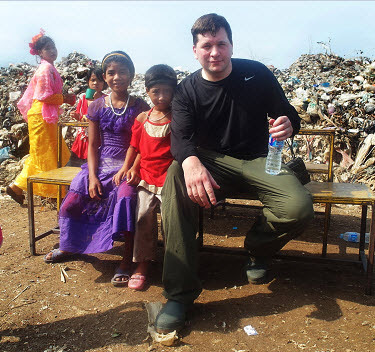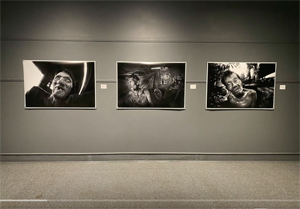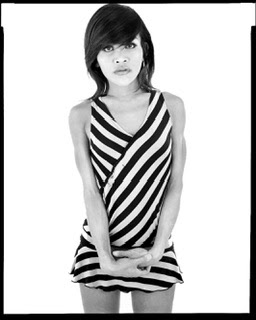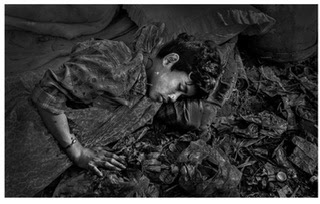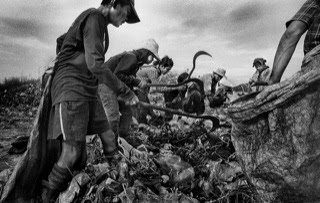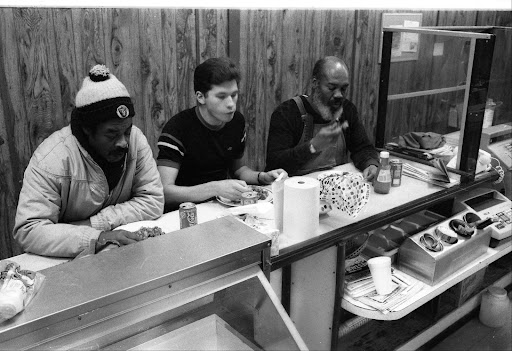
Philip Jones Griffiths and his daughter Fanny Ferrato at an anti-Iraqi war protest in Herald Square, New York. 2003 Photo Donna Ferrato
If you knew Wales, you knew Philip Jones Griffiths. To the end of his life he remained true to his Welshness, which defined him with a power that few environments exert. Both he and his birthplace are rife with contradictions. It is a breathtakingly beautiful land, and relentlessly bleak, a land of strong communities made up of fierce individualists, where physical poverty has produced spiritual richness. Philip's personality reflected this duality. He was a cynical idealist; a serious man with a playful wit; his mind was analytical but his soul was passionate; profoundly moral he could be wickedly lascivious; he was opinionated but compassionate. The one area of his life that was without contradiction, and which dominated him to his last day, was his craft. He was without compromise, without hesitation and without deviation a photographer, one of the greatest photojournalists this profession has been proud to call its own.
He was born in 1936 in a village called Rhuddlan, situated at the far northern edge of Wales. To ensure that the young Master Jones Griffiths was in no doubt that he was Welsh surrounding towns and villages bore such unpronounceable names as Waen Goleugoed, Groesffordd Marli, Pen-Y-Cefn. But however powerfully his birthplace formed the man he was to become, its smallness could never contain his curiosity. The cliché of the photographer introduced to his profession by the family's Kodak Box Brownie was to be his story, with the twist that from an early age he realized it could be his passport to the world outside of the mountains and valleys of his homeland. His parents, however, had other, more practical ideas. He was to become a pharmacist, a plan that he went along with because however tedious the job might be, it would be one that he could practice anywhere in Britain – maybe not such a satisfying passport as photography, but still a pathway to the wider world. He claimed that the decade he spent behind the counter of various pharmacies was wasted time, although there were a couple of side benefits. The training developed his analytical skills, an expertise that was to serve him well as a journalist. It also took him to London, to what was arguably the most dangerous pharmacy in the land – Boots the Chemists in Piccadilly Circus. Famous for being the place where heroin addicts could get their prescribed Methadone and streetwalkers came in to rest their feet, it gave him an introduction to London's netherworld, a subject he found fascinating, and which he started photographing.
He, of course, had a different explanation as to how he got started as a photographer, and the role that the pharmacy played: "I think that the important thing in life is always to be somehow propelled by something, and I'm propelled essentially by boredom, so when I'm bored I've got to do something else." If nothing else, life behind the counter was boring. His ennui-induced photographs were good enough to get the attention of a great picture editor, Dennis Hackett of the London Observer, who gave him valuable advice. "He said look, remember, who, what, why, where, when. Those are the five W's you've got to get right every time when you take a picture. That's what I want to see when I look at a picture. And the more I thought about it, I thought, you know, all of them are standard, but the one in the middle, the why, that is the one that interests me. Why. Call it simple curiosity; call it a search for the truth, call it whatever - but it's the Why, the middle W, that counted."
It was the "Why" that took him in 1966 to the other land that was to powerfully influence him to the end of his life – Vietnam. Of all the many fine photographers who covered that tragic conflict nobody understood Vietnam and the Vietnamese better than Philip. Others may have had a better grasp of the military, others may have been more reckless, but he profoundly comprehended the mentality of the Vietnamese, and as a result was one of the first to realize that the war could not be won, not in the way it was being fought anyway. This awareness was as a result of two things. The first was that Philip thoroughly did his homework. He was passionately opposed to what he called "fireman" journalism, where the photographer jumps into a situation for a couple of days or even weeks, and then is off on to the next conflict, without really having understood what he or she was shooting in either of them. He prepared before going to Vietnam, read about the history, culture and religion of the country. It was important to him to understand the "Why" of Vietnam.
He also made a remarkable discovery upon setting foot on Vietnamese soil for the first time. "I found my village in Wales. In a Welsh village you're taught to keep quiet, to keep your eyes open, to listen, and not to give too much away. I felt that this was the ethic that the Vietnamese themselves lived by. I was fascinated by the fact that the most powerful nation on earth – with a military might never before seen – was being regularly hoodwinked by rice farmers." Over the three years that he covered the war he developed profound insights into what was happening, and what he should be photographing. He realized that the "bang-bang" photographs of combat were, in his words, meaningless. "They only show GIs running up and down hills, and of course it was an enemy lure to get them away from the populated lowlands in preparation for the Tet Offensive. The brilliance of the Vietnamese commander, General Giap, was that he said, 'I will give the American army what they understand, which is taking a hilltop.' I'm glad I missed those battles, because they were a distraction."
He was also well aware of a popular fallacy that persists even to this day – that it was the press coverage of the war that caused the American people to lose faith in the ability of the government and its military commanders to bring the conflict to a successful conclusion. "Although the press coverage had a gripping effect, I vehemently object to the idea that the press lost the war. The truth is that the press was always way behind the American people, who were anti-war long before it was. In general, 95 percent of the press was totally in favor of the war; 4.999 percent was in favor of the war but not the way it was being fought. And then there was me and two Frenchmen." He attributed the public's disillusionment to the fact that, with a conscripted army whose troops served one-year tours and then returned home, the stories of how poorly the war was progressing came not from newspaper articles, but from the newly discharged sons, brothers and nephews of the American family. Press reports merely served as confirmation of the picture that the vets were painting. In fact in both his photographs and in interviews on the subject, Philip was sympathetic to the plight of the GIs. One of my favorite pictures of his from this period is of an American soldier and a Vietnamese child taken in the Mekong Delta in 1967. The poignant expressions on their faces are a clear indication that both were victims of the war. One of his most famous photographs depicts a group of GIs sharing their water canteen with a wounded Vietcong fighter who had fought for three days with a stomach wound over which he had taped a kitchen bowl to keep his intestines from falling out. The concern and respect that the three Americans show for their courageous enemy give the photograph its power. Francis Ford Coppola lifted the scene for his 1979 movie, "Apocalypse Now." When Philip contacted him about this "he said, 'So sue me.'"
His three years covering the war led to the publication of his greatest work, the book Vietnam Inc. published in 1971, and reprinted in 2001. It is not only the finest book to come out of the conflict, it is probably one of the best publications on war ever produced. It is unflinching in its portrayal of war, and although the reader is never in any doubt as to the author's attitude towards the bloodshed, it is compassionate to those for whom the photographer felt compassion. Whenever Philip heard someone describe him as a war photographer he always corrected them – "Anti-war photographer." His fondest personal moment during this time was after the book was published and he had left Vietnam. "I had an assignment to go back, but I was banned. President Thieu uttered the immortal words, 'There are many people I don't want to see back in my country, but I can assure you that Mr. Griffiths' name is at the top of the list.' I begged Life magazine, which had given me the assignment, to get that in writing!"
But go back he did. The cessation of hostilities in 1975 did nothing to decrease his interest in the country. In the last 30 years he made more than 20 return visits, and out of them produced two more fine books – the harrowing Agent Orange: Collateral Damage in Vietnam, published in 2004, and Vietnam at Peace, published in 2005 and reviewed on this Web site in the July issue of that year. He summed up his feelings during the war by saying, "For me, Vietnam was the most intense experience imaginable, and one that was filled with a kind of macabre humor, which of course didn't detract from the tragedy of the whole thing. But most of the time, it was the ultimate clash of civilizations – the wise, smart little David running around irritating the hell out of this huge Goliath. That's an inspiring thing to observe."
For more than 40 years Philip was a member of Magnum, serving five years as its president. It was always a stormy relationship, and he claimed that he had to live in London towards the end of his life because the agency invalidated his health insurance, forcing him to rely on the free medical treatment available in the United Kingdom. Whether or not this was true it was certainly typical of the ambivalent attitude that he had towards the cooperative. His initial expectations of what Magnum could do for him were, however, unreasonably high. "I was 16 when I first read about Magnum. In those days it was a rather more practical problem that I had. My mother had always done my laundry, and what was I going to do when I left home? I read in a magazine that Magnum did Robert Capa's laundry for him. I said, 'That's for me. That's the place I'm going to end up.' Anyway, not only did they not do my laundry, they've done very little else for me over the years, but still it was a great concept, this idea of a band of brothers who would wander around the world righting wrongs, doing humanistic photography, finger on the pulse of humanity, and the very idea that you could just keep traveling – all you needed was a small suitcase and a camera bag. Somehow you need never come home, you could just keep on going from A to B to C to D and you could sort of circumnavigate the world indefinitely; I found all that very exciting. Of course the reality is somewhat different."
He did keep on going to the end of his life, planning another trip to the Far East for this fall that he would never make. He loved being a photographer, and regarded it as a privilege as much as a profession. "I had a grandstand view of this conflict, and that's what being a photographer, or a man with a camera running around Vietnam, afforded me, and for that I'm very grateful. It was almost worth doing without film in the camera. Of course that would have been a crime, but still, what I got out of it was worthwhile in and of itself." His biggest complaint about the "fireman" approach to photography was that you learned nothing, which, in his mind, negated the whole point of being a member of the profession in the first place. He described this peripatetic journalism as "like watching a movie with the lights on and everybody talking. It seems to me that you're losing such a valuable opportunity to learn the truth of what is happening."
During the time period that I've been writing this piece I attended a Barack Obama fund-raiser. At the end of the senator's presentation my friend who invited me and who has been involved in politics for a long time said, "You know what distinguishes him from most other politicians in this country – he's fearless." This characterization also applies to Philip. The two clichés seen most frequently in obituaries are that the subject died of a massive heart attack – nobody seems to die from moderate ones – or after a long battle with cancer. In Philip's case the cliché was a truism. He faced cancer with all the courage that he showed in the other areas of his life, and I am convinced that he lived longer because of it than a less determined man would have done. The thesaurus on my computer tells me that courage "implies not only bravery and a dauntless spirit but the ability to endure in times of adversity." Philip had all of these in spades, but above all he had an uncompromising moral courage coupled with an unerring eye.
He spoke to me once about courage when talking about one near death experience he had during the war. "I've never freaked out. I don't know what the explanation is. The closest I can think of is that if you have a job to do, a mission, a passionate mission, then you don't get scared. You can do it. You find you can do it. It's the people who are insecure or really don't know why they're there, and don't know what they're doing, who suffer, but I knew. I did all of this half for me and half to show the world."









